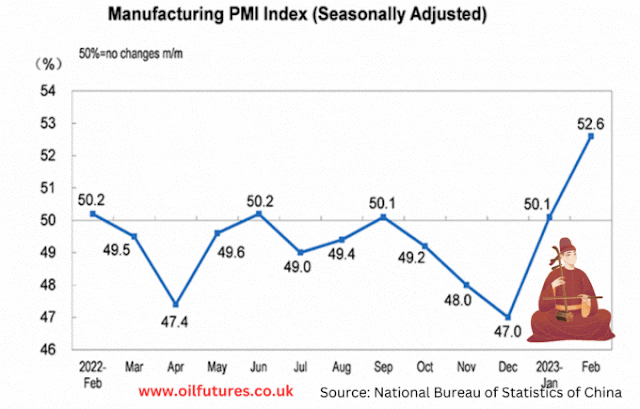The price of crude oil remains in the volatile territory, despite the encouraging news on the Chinese factory activities, indicated by its long-waited Manufacturing Managers' Purchasing Index, known as the PMI; it has gone up by 2.6% in February, relative to what it was in January, 2023.
Investors are now concerned about the new GDP figure set by the Chinese, a 5%, a fall from estimated 5.24% by analysts. China's own target last year was 6%.
The revised official figure, along with the rising US crude inventories and falling natural gas prices, appears to be forming a resistive factor against a steep rise in crude oil price. The combined impact of the factor in question on crude oil prices could be further strengthened in the event of the US Federal Reserve raising interest rates again.
The Chinese have been realistic while revising down the GDP figure, though: its 'Cold War' with the US, both at diplomatic and economic levels, shows no sign of abating, despite the optimism of analysts about the recovery of the Chinese economy.
On the contrary, there are signs that what is left of the relations between the two economic giants can only get worse, if China supplies Moscow with more arms and the US increases what China calls, hostile acts, in the South China Sea and near Taiwan.
In the Middle East, meanwhile, the reported rift between the UAE and Saudi Arabia on Sunday caused alarm and the ramifications were immediately felt across the crude oil markets; the UAE denied that it was leaving the OPEC+ for good; Saudi Arabia remains tightlipped, though.
On the surface, the UAE and Saudi Arabia appear to be seeing eye-to-eye on, when it comes to oil production. They defended the collective measures by the OPEC+, when the latter cut the production, while angering the US.
It, however, is not clear whether the two Middle Eastern giants agree with each other, when it comes to setting the selling price. For instance, Saudi Arabia increased the price of crude oil for Asia and Europe for the second, consecutive month with no sign of the UAE following in the footsteps of the Kingdom on this front.
Of course, the possibility of the UAE leaving the OPEC+ is still in the hypothetical realm. If, however, it comes to that the new found freedom immediately offers the Gulf nation the right to set its own production targets and of course, the prices.
The exponential economic expansion and liberalization of the cultural restraints on the population in Saudi Arabia under the leadership of Prince Mohammad bin Salman have changed the Saudi landscape on many fronts beyond recognition; the celebrations of Halloween and Valentine's Day are cases in point.
If the irreversible progress in the Kingdom continues at this rate, the UAE will be forced to keep up with it in terms of tourist attraction and attraction of investments, which in turn could cause some friction between the two Arab nations.
Saudi Arabia recently offered the olive branch to Yemen that up until recently was at war with the Kingdom, when Houthi rebels used to attack Saudi oil facilities almost daily. The way it has gone down with the UAE remains to be seen, as both countries vying for the influence in the war-ravaged Yemen.
In the short-term, when the two nations try to maximize oil revenues, the Russian factor seems to be playing a significant role in dashing the hopes.
India, for instance, buys a record amount of oil at heavily discounted prices. In February, it was buying 1.6 million barrels a day and the buying spree shows no sign of slowing down. The world's third largest importer of crude oil cashing on the Russian 'black gold' at the expense of two of its traditional sellers, the US and Saudi Arabia.
In fact, the oil imports from the US and Saudi Arabia have fallen by 38% and 16% month-on-month respectively, according to the Indian media. The fall in revenues may have forced the Kingdom to increase the price of oil in a way to compensate for the losses.
In this context, the aspiration of the UAE to increase the production is a case of making hay while the Sun shines. It, however, has contractual obligations to honour as long as it remains in the OPEC+.
On the basis of no smoke without fire, if the UAE was contemplating the possibility of leaving the OPEC+, it makes some sense too.
It is important to note that the source of the story was attributed to someone close to the UAE inner-circle, before being denied by a source higher on the scale of authority.
In Europe, meanwhile, an unexpected Arctic Blast has brought down the temperatures to sub-zero levels in March. This inevitably leads to an increased usage of gas and hence the price of LNG, liquified natural gas, may go up to a certain extent.
The crude builds, falling gas prices and massive job cuts in the technological sector show that the global economy as a whole has not recovered. As a result, the demand for crude oil is going to remain static for the foreseeable future, whatever models predict.
All in all, the tendency of investors in the crude oil markets to pinning their hopes on China, the world's top crude importer, is perfectly understandable, as the West has not reached the economy-recovery mode yet.
HA







